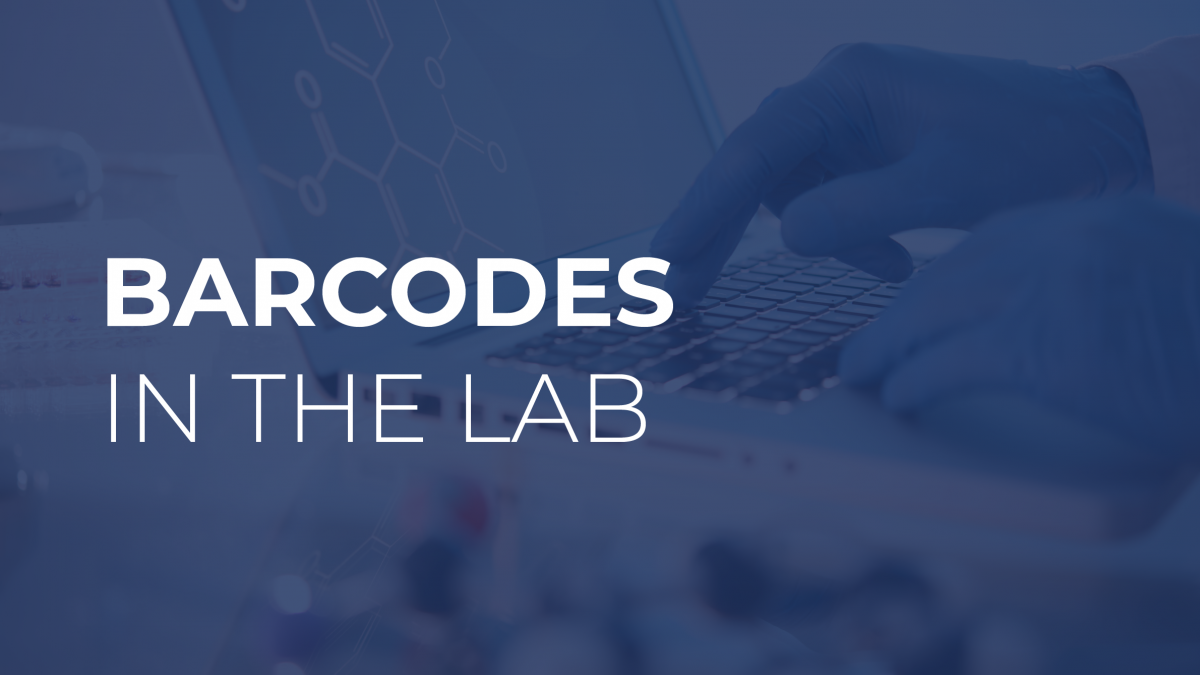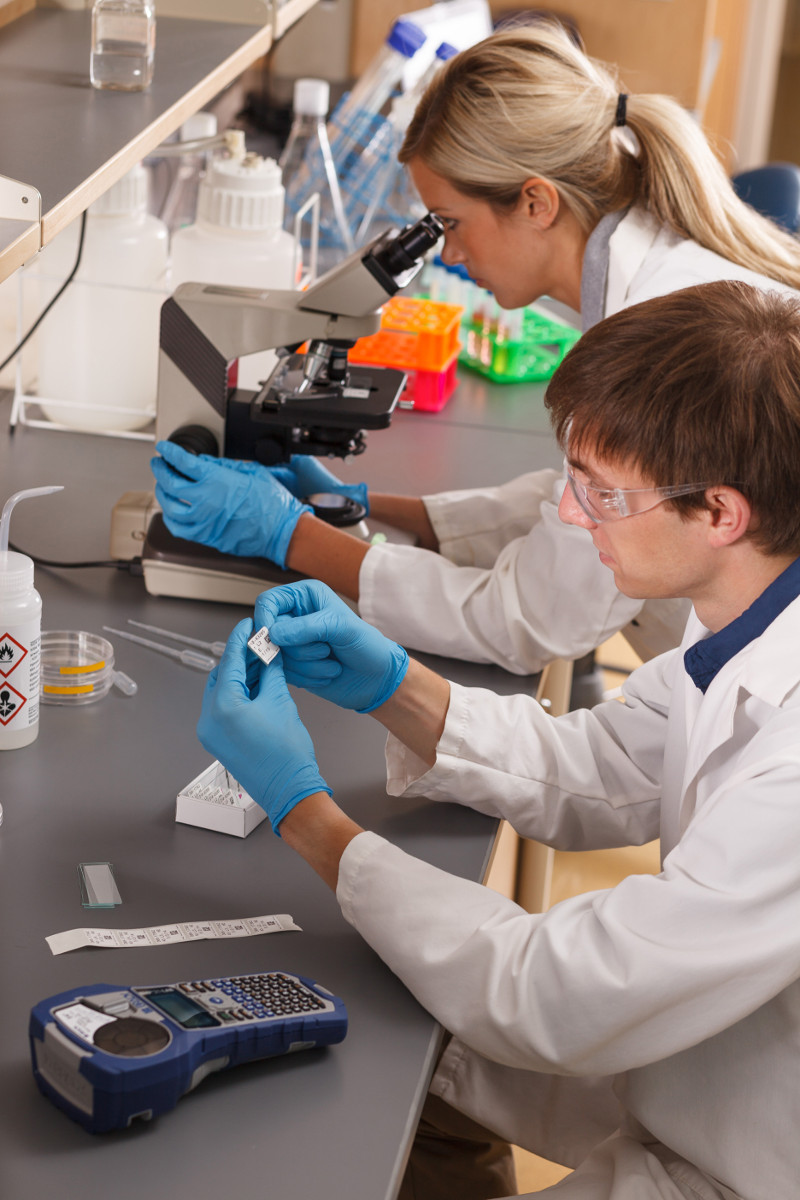Barcodes in the Lab
Barcodes in the Lab
Barcodes are synonymous with specimen labeling accuracy. Barcoding systems are four times less likely to produce errors than manual entry methods. 1 Because of this, barcodes are more common in laboratories now than ever before. Specialized barcode systems help improve every aspect of the laboratory workflow.
Whether you're looking to improve your laboratory management system or implement something new, there is a barcode system for every lab. Follow a sample from collection to storage to see how the latest advancements in barcode technology can improve accuracy in your lab.
Sample Collection

Barcode specimen collection systems have three parts: computer, barcode scanner and label printer.
Whether it's at point-of-care or in the field, collecting samples is an essential but sometimes tumultuous process. In the hospital, nurses and phlebotomists must work expediently to fulfill STAT orders without delay. On the other side of the spectrum, field technicians engaged in ecological research must cope with uncertain environmental conditions. In these conditions, it's unsurprising that handwritten labels are at a high risk of being illegible or incomplete.
With a barcode system, sample data is entered directly into the Laboratory Information System (LIS) database. Samples labeled with a barcode link directly to the LIS data, which makes them much easier to process once they reach the lab.
Hospital
In the hospital, barcodes are already a standard tool for patient identification. When integrated with an LMS database, barcodes help point-of-care staff communicate with doctors and laboratory technicians to ensure samples are collected and labeled accurately.
A barcode specimen collection system has three parts: computer, barcode scanner and label printer. A staff member qualified to collect samples typically follows these steps:
- Scans their ID badge to unlock their computer and identify themselves as the sample collector.
- Identifies the patient by scanning their wristband.
- Prints collection label.
- Draws the sample and labels the tube.
- Scans labeled tubes again for verification. 2
The system automatically applies a timestamp to the collection information, as well as the collector ID. At the lab, the staff member only needs to scan the sample's barcode to document its receipt. With all necessary collection data already uploaded to the LIS, testing can begin right away. 2
Fieldwork
In some areas of scientific study, gathering samples in less-than-ideal conditions is the norm. Fieldwork presents unique challenges to sample collection, but barcodes are an excellent solution.
Despite advances in barcode technology, it is still common for field technicians to rely on handwritten notes to help identify samples. In some cases, handwritten notes are not entered into the laboratory database until months after collection, increasing the risk of data loss. With the use of a barcode system, samples are with accuracy during collection.
One laboratory implemented the following solution:
- Before fieldwork begins, barcode labels are printed in bulk and applied to empty sample containers. Each barcode contains a unique identifier that corresponds to a storage location in the lab.
- After collecting a sample, the field technician scans the barcode on the container, which opens data entry fields on a handheld computer.
- The field technician enters the collection data on the handheld computer.
- Collection data is uploaded to the Laboratory database to await sample arrival. 3
In this solution, sample collection data may be updated at any time by scanning the barcode with the handheld device and updating the relevant data entry fields. From field to lab, the barcode ensures that each sample is traceable and easy to locate.
In The Lab
Barcode labels are printed on the BMP21 and applied to microscope slides in the lab.
After collection, a sample is sent to the laboratory for analysis. Here, barcode technology helps laboratory technicians spend more time analyzing samples and less time agonizing over paperwork.
Audit Trail
An audit trail means everything in laboratory testing. Whether it's for the sake of research reproducibility or patient safety, an audit trail ensures that a sample has passed through the correct protocols during analysis. A LIS database can easily track the audit trail of hundreds of samples, and with an integrated barcode scanner, it can do it quickly and accurately. In barcode-optimized labs, chain-of-custody information -including technician ID, timestamp, and location- is updated automatically with the scan of a sample's barcode.
Verification
Preventing sample destruction and data loss is the purpose of verification. With barcodes, verification is efficient and accurate. Some laboratories implement barcode scanners as another level of verification before using an automated analyzer. Scanning a barcode at an analyzer pulls up the tests ordered for the associated sample. This way, the technician is alerted if there is a mismatch.
Comparators
Sometimes, a large sample is divided into several containers for testing. These "child" samples are linked to the "parent" sample and are labeled using the same unique identifier. For an extra level of verification, a barcode comparator can check the barcodes against one another and ensure that they match.
Sample Storage
Locating samples in storage is easy with barcodes. They may be used in different ways, depending on your system.
A simple method requires only the use of a barcode scanner and a digital spreadsheet. First, a freezer plate is labeled corresponding with the spreadsheet cels (a1, b2, etc.). When samples are placed in the freezer plate, they are scanned into the corresponding cel on the spreadsheet. This creates a map of all the samples in that freezer plate. The process may be repeated by using a new spreadsheet for each new plate.
Another method of sample storage involves embedding the storage location in the sample's unique identifier. This process usually involves custom programming, but it is well worth it for a streamlined workflow.
Bottom Line
Barcodes are an affordable and flexible way to manage samples in your laboratory. When used in combination with a LIS, barcodes are a powerful tool, proven to reduce errors in data entry and processing. From collection to sample storage, barcodes prevent costly mistakes and keep your laboratory operating efficiently.
Want to learn more? Have a chat with our label experts.
Sources:
1 Snyder, Susan R. et al. "Effectiveness of Barcoding for Reducing Patient Specimen and Laboratory Testing Identification Errors: A Laboratory Medicine Best Practices Systematic Review and Meta-Analysis." Clinical Biochemistry, vol. 45, no. 13-14, 2012, https://www.sciencedirect.com/science/article/pii/S0009912012003232?via%3Dihub. Accessed 4 March 2020.
2Trask, Linda. "Barcode Specimen Collection." Medical Laboratory Observer, 14 Dec. 2014, https://www.mlo-online.com/home/article/13007805/barcode-specimen-collection. Accessed 18 March 2020.
3Copp, Adam J. et al. "Barcodes Are A Useful Tool For Labeling And Tracking Ecological Samples." Bulletin of the Ecological Society of America, vol. 95, no. 3, 2014, https://esajournals.onlinelibrary.wiley.com/doi/pdf/10.1890/0012-9623-95.3.293. Accessed 18 March 2020.
4Hazen, Amanda. "Tips from the Repository Trenches: Using Barcodes to Track Samples." Addgene Blog, 6 Oct. 2015, https://blog.addgene.org/tips-from-the-repository-trenches-using-barcodes-to-track-samples. Accessed 18 March 2020.

